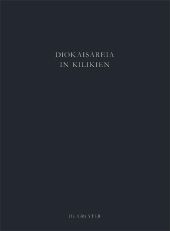 Neuerscheinungen 2013Stand: 2020-01-07 |
Schnellsuche
ISBN/Stichwort/Autor
|
Herderstraße 10
10625 Berlin
Tel.: 030 315 714 16
Fax 030 315 714 14
info@buchspektrum.de |

Johannes Chr. Linnemann, Klaus Trampedach, Detlev Wannagat
(Beteiligte)
Die Nekropolen von Diokaisareia
Dissertationsschrift
2013. 352 S. 240 col. ill., 5 Faltkarten. 345 mm
Verlag/Jahr: DE GRUYTER 2013
ISBN: 3-11-025735-1 (3110257351)
Neue ISBN: 978-3-11-025735-9 (9783110257359)
Preis und Lieferzeit: Bitte klicken
Die an den südlichen Ausläufern des Taurus gelegenen Ruinen in dem modernen Ort Uzuncaburc gehören zum hellenistischen Heiligtum des Zeus-Olbios und zur antiken Stadt Diokaisareia. Die beeindruckend guterhaltene Architektur spiegelt die wechselvolle Geschichte dieses antiken Ortes wider: Das extraurbane Heiligtum war in hellenistischer Zeit das Machtzentrum eines ausgedehnten Tempelstaates, in der frühen Kaiserzeit entstand um das Heiligtum eine Stadt, die bis in das 7. Jahrhundert n.Chr. blühte. Eine Dokumentation aller Oberflächenbefunde sowie detaillierte Bauaufnahmen wurden in den Jahren 2001-2006 von einer internationalen Forschergruppe aus Archäologen, Bauforschern, und Historikern durchgeführt. Mit der Reihe werden einzelne Materialgruppen und Gebäudekomplexe vorgelegt. Damit bietet sie einen wesentlichen Beitrag zur antiken Siedlungsgeschichte Kleinasiens und zur Entwicklung antiker Architektur vom Hellenismus bis in die Spätantike.
Im Umfeld des antiken Diokaisareia im Rauhen Kilikien (Türkei) lassen sich fünf Nekropolen feststellen, die vorwiegend an wichtigen Zufahrtsstraßen der Polis liegen. Die etwa 750 aufgenommenen Gräber und Grabanlagen sind typologisch in Sarkophage, Felsgräber und Grabbauten zu unterteilen. Anhand der in den Inschriften genannten Berufsnennungen lässt sich zumindest im Ansatz ein Bild des städtischen Lebens rekonstruieren. Während nur wenige Gräber aus der Zeit vor der Stadtgründung im 1. Jh. n. Chr. datieren, wurde der Großteil in der römischen Kaiserzeit und in frühbyzantinischer Zeit angelegt.
On the southern fringes of the Taurus mountains, in the modern town of Uzuncaburc, lie the ruins of the Hellenistic temple of Zeus-Olbios and of the ancient city of Diocaesarea. The impressive architectural remains reflect the turbulent history of the ancient site. In the Hellenistic period the extra-urban sanctuary was the centre of power of an extensive temple state, while in the early Roman Empire a city was established around the temple that blossomed until the 7th century AD. In 2001-2006 a record of all surface finds and a detailed documentation of buildings were made by an international team of archaeologists, architectural experts and historians. The series of monographs presents individual groups of material and building complexes, so offering an important contribution on the history of settlement in ancient Asia Minor and the development of ancient architecture. The series will probably consist of five volumes:Volume I: Norbert Kramer, The Ceramic Survey (2012)Volume II: Marcello Spanu, The Theatre (2011)Volume III: Johannes Linnemann, The Necropoleis (2013) The next volume planned isVolume IV: Detlev Wannagat, The Sanctuary of Zeus-Olbios
Five necropoleis have been identified in the area around Diokaisareia in Rough Cilicia (Turkey). Most of them lie along the roads leading into the polis. Some 750 burials and graves that have been recorded are arranged here by type: sarcophagi, rock graves and funerary monuments. The professions named in the inscriptions go some way to allowing a preliminary reconstruction of life in the city. Only a few graves date to the years before the foundation of the city in the 1st century AD, most of them are from the Roman imperial and early Byzantine periods.


